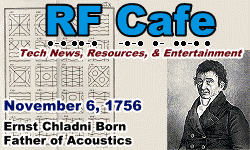|
 November 30 November 30
1603: William Gilbert, the "father of electrical studies," coiner of
the names of electric attraction, electric force, and magnetic poles, died. 1756:
German physicist Ernst Chladni, known as "the father of acoustics," was born. 1782:
The U.S. and Britain signed preliminary peace articles in Paris, ending the
Revolutionary War.
1874: Sir
Winston Churchill was born. 1835:
Samuel Clemens
(aka Mark Twain) was born, the same year as an appearance of Halley's Comet and,
amazingly, the comet's next appearance came during April 1910, the year of Clemens'
death (throughout his life, Clemens said that he would "go out with the comet").
1850: Germain
Hess, early thermochemistry researcher who developed Hess's law of constant
heat summation, died. 1858: John Mason patented the screw neck bottle (Mason
Jar). 1954: In Sylacauga, AL, Ann Hodges, was bruised on the arm and hip by
a meteorite (Hodges
Meteorite) that fell through the roof of her house into her living room. 1983:
Radio Shack announced Tandy Model 2000 computer (80186 chip). 1999: British Aerospace
and Marconi Electronic Systems merged to form
BAE Systems.
| Jan
| Feb | Mar |
Apr | May |
Jun | Jul |
Aug | Sep |
Oct | Nov |
Dec |
Note: These
historical tidbits have been collected from various sources, mostly on the Internet.
As detailed in
this article, there
is a lot of wrong information that is repeated hundreds of times because most websites
do not validate with authoritative sources. On RF Cafe, events with
hyperlinks have been verified. Many years ago,
I began commemorating the birthdays of notable people and events with
special RF Cafe logos.
Where available, I like to use images from postage stamps from the country where
the person or event occurred. Images used in the logos are often from open source
websites like Wikipedia, and are specifically credited with a hyperlink back to
the source where possible.
Fair Use laws permit
small samples of copyrighted content.
|








 November 30
November 30